EL VPM: UNA TÉCNICA VARIACIONAL PARA SIMULAR LA RESPUESTA SÍSMICA DE VALLES ALUVIALES SOMEROS
DOI:
https://doi.org/10.18867/ris.67.206Resumen
Se presenta el Método de Proyección Variacional (VPM, por sus siglas en inglés) para calcular la respuesta sísmica tridimensional de valles aluviales someros. La solución está basada en una formulación variacional de Galerkin de forma débil para el problema de un estrato irregular de geometría suave que sobreyace a un semiespacio elástico. La formulación de Galerkin se aplica mediante una familia de funciones de prueba para establecer la dependencia respecto a la profundidad. Las ecuaciones diferenciales parciales de la elasticidad dinámica se "proyectan" al plano horizontal en superficie donde se resuelven usando un esquema pseudoespectral. Aquí, las ecuaciones son resueltas con diferencias finitas para las derivadas en el tiempo y transformada rápida de Fourier para las derivadas horizontales en el espacio. La irradiación de energía al semiespacio se incluye aproximadamente usando como solución de referencia la respuesta
unidimensional en cada sitio. Se dan ejemplos del comportamiento numérico del método y de su exactitud para modelos de valles someros en 2 y 3 dimensiones. Se discute la factibilidad de mejorar el método, particularmente en las condiciones de frontera en la base del modelo.
Descargas
Citas
Aki, K (1988), “Surface motion of a layered medium having an irregular interface due to incident plane SH waves”, Journal Geophysical Research, Vol. 75, pp. 933-954.
Ávila, R, M Suárez y F J Sánchez-Sesma (1993), “Simulación de la propagación de ondas sísmicas en configuraciones irregulares con un método pseudo-espectral”, Memorias del X Congreso Nacional de Ingeniería Sísmica, Puerto Va1larta, Jal., México, pp. 182-189.
Faccioli, E, F Maggio, A Quarteroni y A Tagliani (1996), “Spectral domain decomposition methods for the solution of acoustic and elastic wave equations”, Geophysics, Vol. 61, No. 4, pp.1160-1174.
Frankel, A (1993), “Three-dimensional simulations of ground motion in the San Bernardino Valley, California, for hypothetical earthquakes on the San Andreas fault”, Bulletin of Seismological Society of America,. Vol. 83, 1020-1041.
Furumura, K y H Takenaka (1996), “2.5 modelling of elastic waves using the pseudospectral method”, Geophysical Journal International, Vol. 124, pp. 820-832.
Geller, R J, T Hara y S Tsuboi (1990), “On the equivalence of two methods for computing partial derivatives of seismic waveforms”, Geophysical Journal International, Vol. 102, pp. 499-502.
Geller, R J y T Ohminato (1994), ”Computation of synthetic seismograms and their partial derivatives for heterogeneous media with arbitrary natural boundary conditions using the Direct Solution Method”, Geophysical Journal International, Vol. 116, pp. 421-446.
Geller, R J y T Hatori (1995), “DSM synthetic seismograms using analytical trial functions: plane-layered, isotropic, case”, Geophysical Journal International, Vol. 120, pp. 163-172.
Graves, R W y R Clayton (1992), “Modeling path effects in three dimensional basin structures”, Bulletin of Seismological Society of America, Vol. 82, pp. 81-103.
Horike, C (1990), “A finite element method for solving Helmholtz type equations in wave guides and other unbounded domains”, Mathematics of Computation, Vol. 39, pp. 209-324.
Kawase, H y K Aki (1989), “A study on the response of a soft basin for incident S, P and Rayleigh waves with special reference to the long duration observed in Mexico City”, Bulletin of Seismological Society of America, Vol. 79, pp. 1361-1382.
Luco, J E, H I Wong y F C P De Barros (1990), “Three-dimensiona1 response of a cylindrica1 canyon in a layered half-space”, Earthquake Engineering and Structural Dynamics, Vol. 19, pp. 799-817.
Olsen, K B, R J Archuleta y J R Matarese (1995), “Three-dimensional simulation of a magnitude 7.75 earthquake on the San Andreas fault”, Science, Vol. 270, pp. 1628-1632.
Olsen, K B, R Madariaga y R J Archuleta (1997), “Three-dimensional dynamic simulation of the 1992 Landers Earthquake”, Science, Vol. 278, pp. 834-838.
Pérez-Rocha, L E, F J Sánchez-Sesma y E Reinoso (1991), “Three-dimensional site effects in Mexico City: evidences from accelerometric network observations and theoretical results”, Memorias, 4th International Conference on Seismic Zonation, Stanford, California, agosto 25-29, Vol. II, pp. 327-334.
Perrot, J, F J Sánchez-Sesma, K Irikura, J L Rodriguez-Zúñiga y R Ávila (1995), “Simulation of seismic response of Osaka basin during the January 17, 1995 Kobe earthquake using the Variational Projection Method”, Memorias, AGU Fall meeting, San Francisco.
Sánchez-Sesma, F J (1987), “Site effects on strong ground motion”, Earthquake Engineering and Structural Dynamics, Vol. 6, pp. 124-132.
Sánchez-Sesma, F J, R Madariaga y K Irikura (2001), “An approximate elastic 2D Green’s function for a constant-gradient medium”, Geophysical Journal International, Vol. 146, pp.237- 248.
Sánchez-Sesma, F J, J Ramos y M Campillo (1993), “An indirect boundary element method applied to simulate the seismic response of alluvial valleys for incident P, S and Rayleigh waves”, Earthquake Engineering and Structural Dynamics, Vol. 22, pp. 279-295.
Sánchez-Sesma, F J y F Luzón (1995), “Seismic response of three-dimensional alluvial valleys for incident P, S, and Rayleigh waves”, Bulletin of Seismological Society of America, Vol. 85, pp. 269-284.
Sánchez-Sesma, F J, K Irikura, J Perrot, J L Rodríguez-Zúñiga y R Ávila (1996), “The Variational Projection Method: A new technique to simulate the seismic response of shallow alluvial valleys”, Memorias, 11th World Conference on Earthquake Engineering, Acapulco, México, Artículo No.946, CD-ROM.
Singh, S K, R Quaas, M Ordaz, F Mooser, D Almora, M Torres y R Vázquez (1995), “Is there a truly “hard” rock site in the Valley of Mexico?”, Geophysical Research Letters, Vol. 22, pp. 481- 484.






